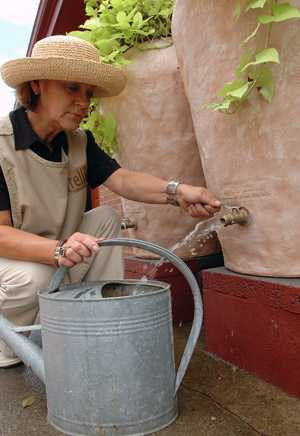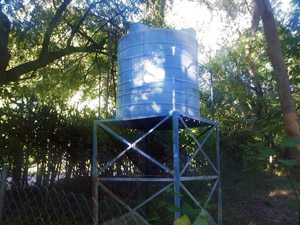Rainwater Collection

Collecting and using rainwater can be a great way to conserve resources 1. Some people use rainwater for watering plants, cleaning, bathing, or drinking. Rainwater collection is not allowed in all places. Some states consider rainwater the property of the state and prohibit its collection, so you should consult with your local government (for example, your environmental quality department or health department) before proceeding 2.
Germs and Other Contaminants
While useful for many things, rainwater is not as pure as you might think, so you can’t assume it’s safe to drink. Rain can wash different types of contaminants into the water you collect (for example, bird poop on your roof could end up in your water barrel or tank). Rainwater can carry bacteria, parasites, viruses, and chemicals that could make you sick, and it has been linked to disease outbreaks 3-4.
The risk of getting sick from rainwater may be different depending on your location, how frequently it rains, the season 5, and how you collect and store the rainwater. Dust, smoke, and soot from the air can be dissolved in rainwater before it lands on your roof. Roofing materials, gutters, piping, and storage materials can introduce harmful chemicals like asbestos, lead, and copper to the water, though building standards minimize some of this 6-8. Dirt and germs can be washed into collected rainwater from the roof, especially when rain follows several days of dry weather 3-4, 9.

Rain barrels, for example, do not provide any type of disinfection or filtration. Adding chlorine or iodine to water does not protect against chemicals, and some parasites are very chlorine tolerant. Boiling the water will kill germs but will not remove chemicals. Using a simple device called a "first flush diverter" to remove the first water that comes out of the system (which may have been sitting) may help avoid some of these contaminants 8, 10.
Some cisterns, which are common in certain areas, can provide safe water supplies. Some people add purchased, treated water to the rainwater they collect in their cistern. This may make the treated water less safe. Cisterns that are intended for drinking water should be properly maintained 8, 11. Consider adding a screen to the water inlet or emptying the rain barrel in less than 10 days to prevent mosquitoes from using the rain barrel as a breeding site 9, . Water intended for drinking needs to be filtered, disinfected, and tested regularly 9, 12.
Preventing Illness
If you collect and store rainwater for drinking, you have a private, or individual, water system and are responsible for ensuring that your water is safe. You should have your water and your system tested regularly and maintain the system properly 4-5. When rainwater is used as a supplemental water source, homeowners should ensure that rainwater cannot enter pipes containing safe drinking water 4, 6. Contact your state or local health department for more information.
To lower your risk of getting sick, consider using rainwater only for uses such as watering plants that you don’t eat, washing items that are not used for cooking or eating, and bathing (keeping water out of your mouth and nose). If possible, avoid using rainwater for drinking, cooking, brushing your teeth, or rinsing or watering plants that you intend to eat. Instead, use municipal tap water if it is available, or purchase bottled or bulk water for these purposes.
If you have a weakened immune system, you should be especially careful when choosing your drinking water source. Discuss this with your healthcare provider.
References
- U.S. Environmental Protection Agency. Managing Wet Weather with Green Infrastructure Municipal Handbook: Rainwater Harvesting Policies. 2008.
- National Conference of State Legislatures. State Rainwater Harvesting Statues, Programs and Legislation. State Rainwater Harvesting Statues, Programs and Legislation. 2012.
- Ahmed W, Gardner T, Toze S. Microbiological quality of roof-harvested rainwater and health risks: a review. J Environ Qual. 2011;40:13-21.
- Lye, DJ. Health risks associated with consumption of untreated water from household roof catchment systems. J Amer Water Res Assoc. 2002;38(5):1301-6.
- Vialle C, Sablayrolles C, Lovera M, Jacob S, Huau MC, Montrejaud-Vignoles M. Monitoring of water quality from roof runoff: Interpretation using multivariate analysis. Water Res. 2011;45(12):3765-75.
- NSF International. Rainwater Collection. 2012.
- NSF International. NSF Protocol P151 – Health effects from rainwater catchment system components. 2012.
- Oregon Department of Consumer & Business Services, Building Codes Division (BCD). Oregon Smart Guide to Rainwater Harvesting [PDF - 20 pages]. 2012.
- Virginia Department of Health. Virginia Rainwater Harvesting & Use Guidelines [PDF - 15 pages]. 2011.
- Lee JY, Kim HJ, Han MY. Quality assessment of rooftop runoff and harvested rainwater from a building catchment. Water Sci Technol. 2011;63(11):2725-31.
- Georgia Department of Community Affairs. Georgia Rainwater Harvesting Guidelines [PDF - 70 pages]. 2013.
- Virginia Water Resources Research Center. Evaluation of Rooftop Rainfall Collection-Cistern Storage Systems in Southwest Virginia [PDF - 49 pages]. 1998.
- Page last reviewed: July 18, 2013
- Page last updated: July 18, 2013
- Content source:


 ShareCompartir
ShareCompartir